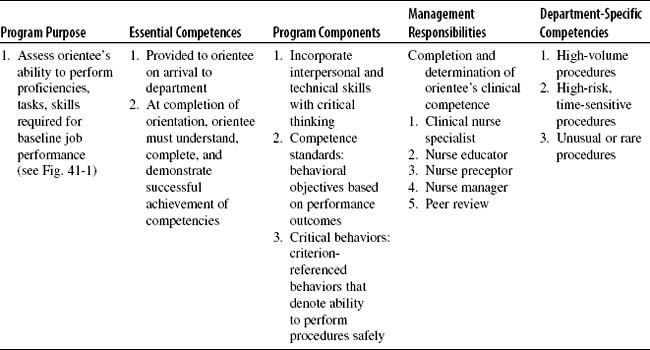CHAPTER 41 Education: Professional, Patient, and Community
I. EDUCATIONAL PRINCIPLES
A. Adult Learning Concepts
d. Adult learners expect and appreciate learning that is immediately applicable to the present situation
2. Ideal conditions for adult learning
Table 41-1 ADAPTING ADULT LEARNER CONCEPTS
| Learning Concepts | Adaptations |
|---|---|
| Life experiences | Incorporate personal experience into learning experience |
| Learning new material | Make information relevant to learner |
| Physical comfort | Minimize physical distractions |
| Anxiety | Acknowledge and provide support to reduce learner’s anxiety and fear |
| Problem-centered | Assist learner to recognize problem and find solutions |
| Information recall | Use short words and sentences, incorporate repetition, give goal-related suggestions, provide concrete and specific statements |
II. PROFESSIONAL EDUCATION
A. Emergency Nursing Knowledge Base
2) Effective interfacing with prehospital care providers (e.g., emergency medical technicians [EMTs], paramedics, firefighters, and law enforcement officers)
2. Work environment conditions
f. Patients represent a microcosm of general population at large, including existence of violent situations
Table 41-2 EMERGENCY NURSING KNOWLEDGE COMPOSITE
| Specialty Knowledge | Population Groups | Flow of Patient Care |
|---|---|---|
B. Learning Facilitator Roles
1) Serves as resource to staff, nursing students, and other health care personnel in the acquisition of knowledge and skills related to nursing practice
1) Collaborates with clinical nurses and other members of the health care team to resolve complex clinical situations for specialty needs of emergency patients
1) Critically analyzes current nursing research and disseminates relevant findings to improve patient care and patient outcomes
1) Models excellence in emergency nursing practice through use of assessment, planning, implementation, and evaluation
2) Assists and provides direction to nursing personnel with clinical decision-making, priority setting, stabilization, and resuscitation
4. Nurse administrator/manager
C. Department Orientation
a. Preceptor-sponsored: a preceptor is a specially trained nurse who serves as a role model and resource person for new employees
3) Competencies should complement and correlate with department’s ongoing quality improvement program





